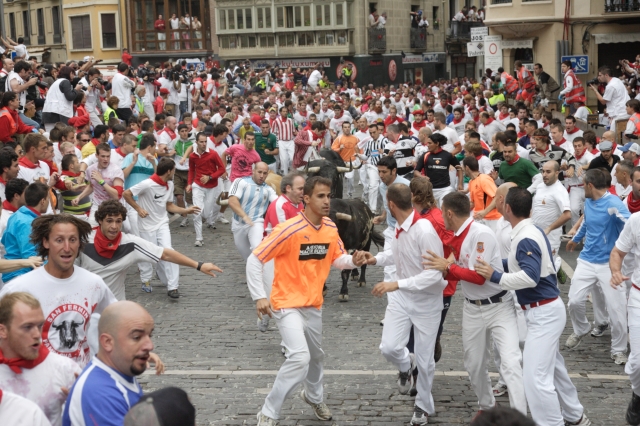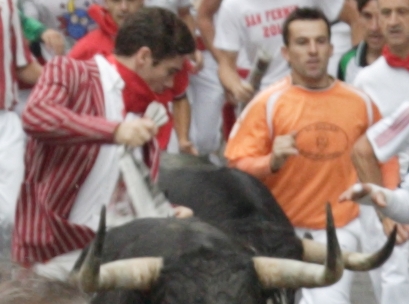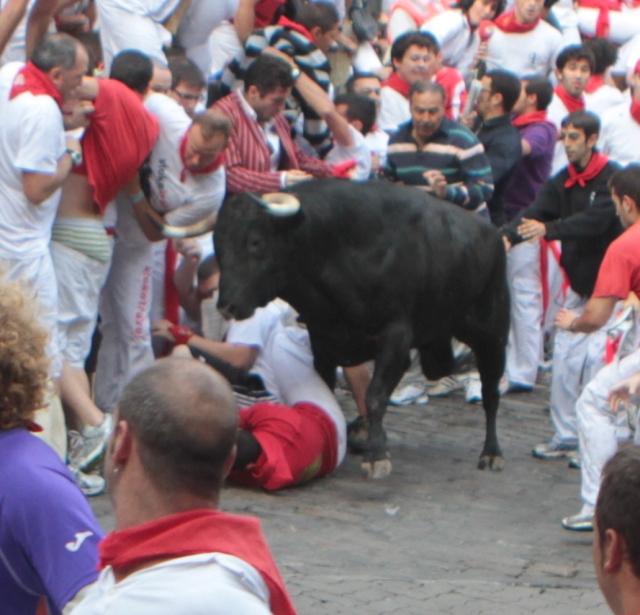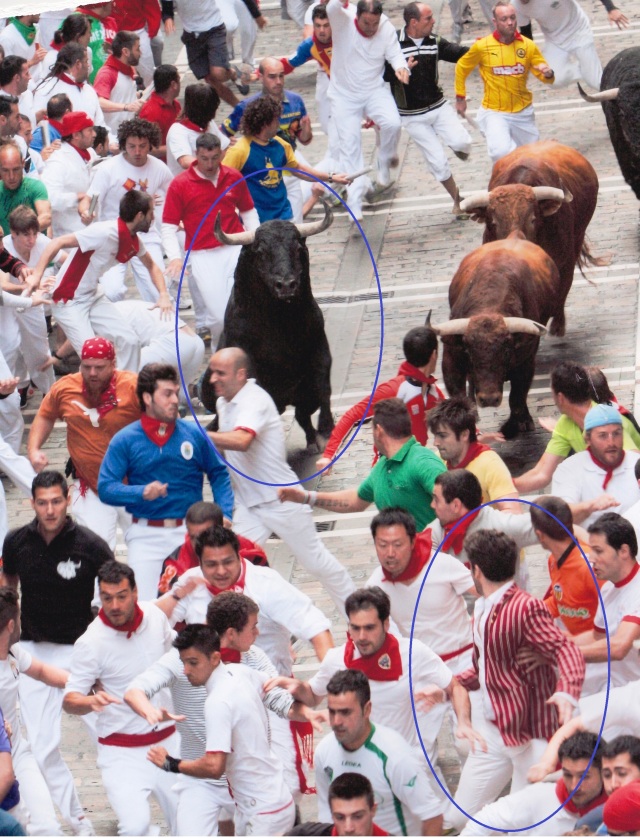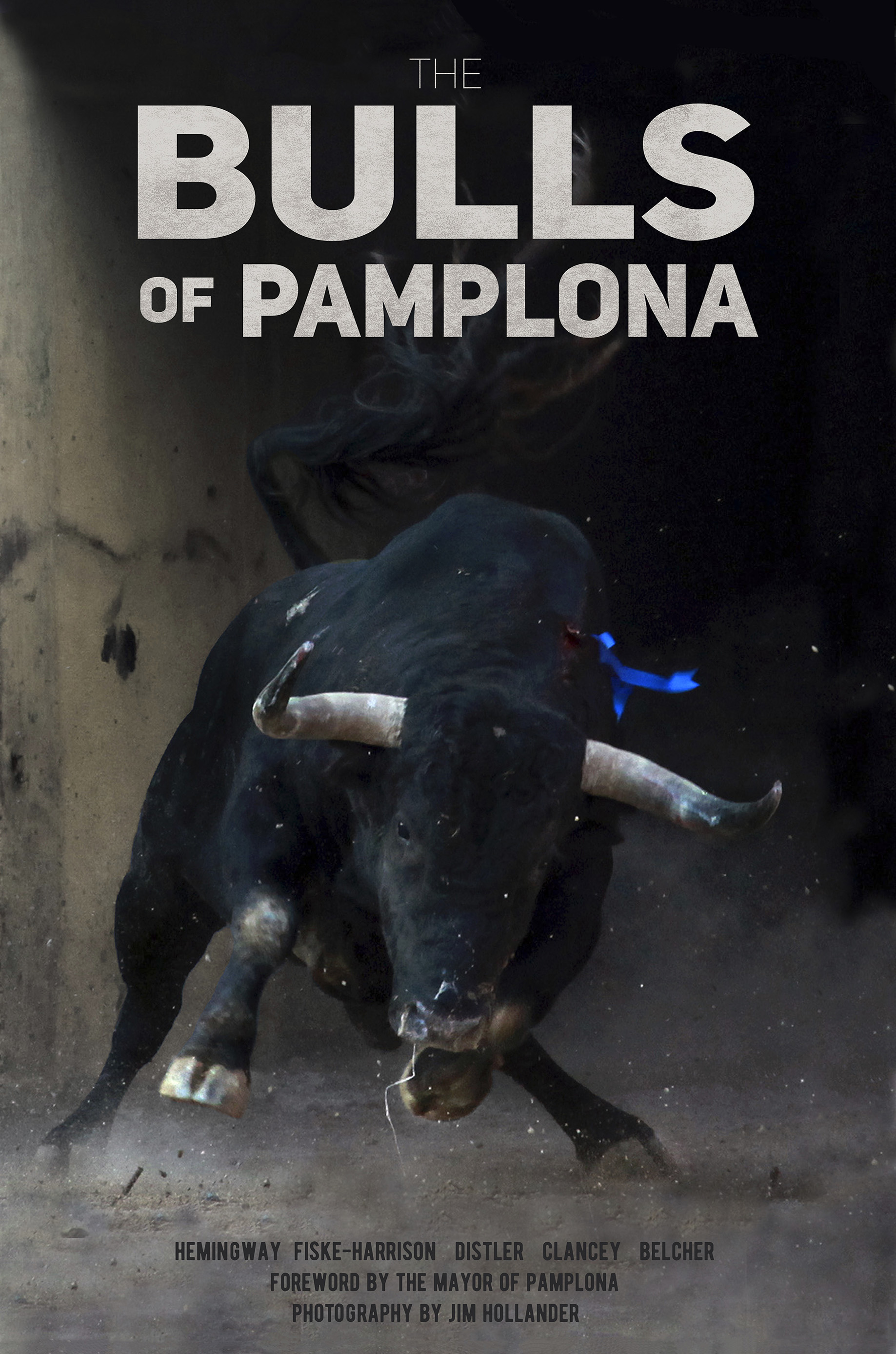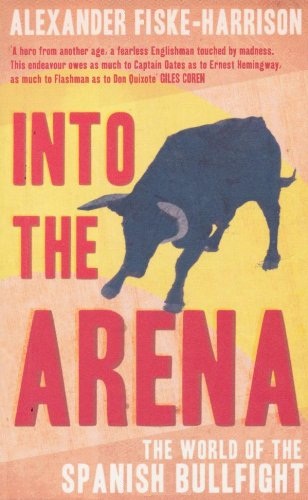This is the full version of what I submitted for my regular column ‘By The Sword’ in Taki’s Magazine. As you can see here, about half of it was cut, leaving only a narcissistic skeleton, rather than the flesh – the other people – which is what Fiesta is all about. (I forget whether it was Stephen Ibarra or Rick Musica, those pillars of Pamplona, who said that if they took the bulls away from the feria, but kept the people, they’d still come, but if they took away the people, it wouldn’t be worth it for the bulls alone. Which is why so many of them are mentioned. Those that I could not fit even in this too long piece are mentioned in the post-script.)
The great thing is to last and get your work done and see and hear and learn and understand; and write when there is something that you know; and not before; and not too damned much after.
Ernest Hemingway, Death In the Afternoon 1932
In 2009 I first came to Pamplona to run with the bulls to give a first-person perspective to that chapter of my book on the “world of the Spanish bullfight.” I was terrified in that complete and overwhelming way that total ignorance brings, standing on a street corner where a friend had stood for his first time the day before – that was the sum total of advice I had been given – and waiting for death or injury to come.
I comported myself honourably but not brilliantly and did so again two days later before boarding a train to Barcelona and vowing never to return. The relentless loud, bad music, the all-day drinking by people who clearly hadn’t washed in some time, and the fact that the corridas, ‘the bullfights’ (as I’ve said in this column before, it’s neither a fight nor a sport) were made abysmal by even worse music played by multiple bands in the audience in apparent competition with one another, all combined to set me firmly against in this Navarran Fiesta. The place seemed crude, cruel and uncouth compared to the sun-blasted, deathless dignity of Andalusia where my aficion for the bulls was formed.
Then, two years later, after the book came out, a Reuters journalist called Angus MacSwan asked to interview me. By then I had been worn smooth and glib by endlessly justifying the ritual injuring and killing of animals in the plaza de toros and so was surprised when he told me outright that he liked the book but that I was wrong about one thing: Pamplona.
I remained sceptical, but came to the view that, with its density of English speakers with a nominal interest in los toros, and journalists sending photos and stories back down the wires, it might turn out to be a marketing opportunity at the very least. So I booked my flights and a room for the duration of the feria de San Fermín, the summer fair dedicated to the first bishop of Pamplona.
And it turns out that the man from Reuters was right. My two earlier runs in ’09 to one side, I had spent the year of 2010 toreando cattle around Spain and Portugal, and leapt into the streets with a confidence I have not since recovered, running directly between two bulls in my old high school athletics blazer.
The obvious advantage of having a bull in front of you in the street is that he clears a path through the 2-4,000 people packed into that half a mile. The one behind is the real problem: his right horn is, at the very moment the photographer caught, cracking the screen of the iPhone in my back pocket, a contemporary variant of the cigarette case stopping the opponent’s bullet in a duel. (I had the detail of the image as the screensaver on that cell-phone, which I never had repaired. It served as a brilliant memento until it was stolen a year later at a bar less than a hundred yards away from that spot: such is Pamplona. This year I took an actual silver cigarette case in its place just in case.)
Two days after that moment of encierro – ‘bull-run’ – glory I found myself pinned against the wall by another bull, again captured on film, and understood that there was more technique to this than I had at first thought.
Between that realisation and the astonishing variety of people I met there in a very short time, I developed an strange all-encompassing love for the city despite its smells, sounds, occasional vulgarities and infrequent barbarities. And that love has continued to grow as I realise that its vices, for all the annoyance they cause, are also part of the reason you fall in love in the first place. In a world where people of all political persuasions seem to want the state to intervene in people’s right to decide their own destiny – from smoking cigarettes to riding a bicycle without a helmet – to go to a town where six half ton fighting bulls and six one ton steers are released into the streets by the city council while the police stand by and watch is one of the great pleasures in life.
However, this is no simple act of hedonism. The great Spanish runners like Julen Madina, Miguel Angel Eguiluz or Josechu Lopez – and even the Americans from the regal Maestro Joe Distler to the young(ish) pretender to the throne Tom Turley – all have a spirituality or at a least a philosophy of why they run.
I wrote about mine in The Spectator, but to summarise: I see it as a pagan thing and, as such, as being about the animal within us – something reflected in the cave art which litters that part of Spain. In this the encierro differs massively from the corrida in which the bulls are destined to die that evening. What happens in the plaza de toros is the ritualised and stylised killing of an animal by a man every fibre of whose being, from his stance to his technique to the gold braid on his silk costume, shows how far above animals, Nature, and even Death itself he is. The corrida is not pagan, but is the true embodiment of that strange cocktail of a phrase: Roman Catholic.
It is this pagan nature of the festival, the bacchanal and the abandonment, which allows the extreme depth of bonding between the people involved. If you have drunk late into the night with someone, and then run shoulder to shoulder with them as nine tonnes of hoof and horn bounce the cobbles beneath your feet, they become as brothers and sisters to you.
This also provides a wonderful process of filtration, a vetting of men and women by means of blood. No one boring comes to Pamplona in the first place, and no one weak stays for more than a day. It is only there that I get to meet men like the now sorely missed Keith ‘Bomber’ Baumschen, who once ended a story with the immortal line, “and they said you sold us the grenades, you throw them through f***ing the window.” (The rest of the story I cannot repeat, nor the name of the other Pamplona regular whose unit ‘extracted’ him from an Oriental prison.) Or Larry Belcher who traded the big bulls of rodeo for the smaller and more savage toro bravo cousins. Or that Welsh prince of Pamplona, Noel Chandler who has seen more corridas than most Spaniards, and in his running days traversed the largest pile-up of animals and men in the bullring mouth which the town has ever seen. Or Angus ‘the Scottish Rocket’ Ritchie whose can be seen cutting through the cattle morning after morning on ‘the curve of the death’ in the yellow shirt of his local football team Partick Thistle. As can be seen in the series of photos from this year, the timing of running this curve is everything as the bulls are moving at 20 mph, and as yet I have never got it right, either being too late.

Entering frame, bottom centre (Photo: http://www.sanfermin.com)
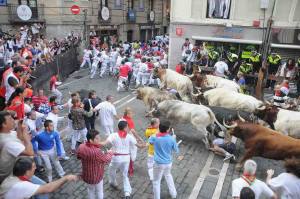
Centre (Photo: http://www.sanfermin.com)
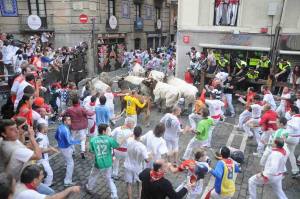
(Photo: http://www.sanfermin.com)
Or as shown in this ‘our eyes met across a crowded room’ shot from last year, too early.
My finest run this year was actually on the long road of calle de la Estafeta, when I set off at a jog in the middle of the street and slowly accelerated to a sprint all the while either throwing the drunks and first-timers out of my way – and that of the bulls, thus to safety – or hurdling them where they lay. The entire herd, a tight pack of six with a couple of one ton steers in the front, came up on my left hand side and I looked down admiringly at the silky black flanks pulsing and surging next to me, the modern incarnation of the wild aurochs which in other breeds we have converted to a hornless, harmless box of meat and milk on legs. However, lost in this atavistic reverie, I failed to spot another runner go down in front of me and I hit the asphalt at a flat sprint.
The one rule of bull-running, especially in Pamplona, but even other, more ancient runs like Cuéllar (which I wrote about for the Financial Times) is do not get up, the bull’s horns are low for evolutionary reasons, and on your knees your gut appears at the height of the herbivore’s ancestral enemy the wolf. This was the fatal error made by 22-year-old American Matthew Tassio in 1997. (The last death was actually a very experienced Spaniard called Daniel Jimeno Romero in 2009 two days before my own first run. Since Ernest Hemingway first went to Pamplona in 1923 and wrote his dispatches which, along with this first novel The Sun Also Rises, made the city famous, fifteen people have died.)
However, lying in the middle of the street with at least four one ton oxen and four hundred people about to run over you, I reverted to my torero training and rolled sideways, bringing down a certain number of people on top of me, but far fewer than would have been the case had I stayed where I was. As I reached the gutter I felt two strong pairs of hands grab my shoulders, and was hauled to my feet by my old friends John Hemingway (the author grandson of Ernest) and Graeme Galloway (a Scotsman who is larger than life or any description I have room to give.) I carried on running but the moment and the herd had passed. However, for this year, it was good enough. There will be others.
To paraphrase the opening of the passage with whose closing lines I began, if I could have made this enough of an article, it would have had everything in it. It would have had Matt Carney, an Irish American veteran of Iowa Jima who started the whole ‘foreigners running with bulls’ thing since Hemingway chose not to get in the street, a difference over which they fought as described in James A. Michener’s great book Iberia. It would have had Tom Gowen who arrived with terrible scars inside and out from his time in the Marines in Vietnam. It would also have had his old friend Robin Kelley O’Connor, a former wine expert from Christie’s, who has similar abdominal scars to Tom, but from a bull which saved his life twice, once by making him miss a flight on which all passengers died, the other when they had to open him up again years later and found other, hidden things that shouldn’t have been there at all. It would have had José Antonio Sanz Amador who has saved the lives of many a foreign novice, something made more amazing by him being deaf and mute, although this year he was in jail for something we can’t talk about. And Jim Hollander who came here before all of us to run and now is the finest photographer here (as his book shows), taking it as a break from war zones around the world.
And the Hoskins boys who run in the black and white colours of their rugby team, the Barbarians, the youngest of whom, Owain, had his photo go round the world on Saturday as he leapt over a sea of human and bulls in the biggest pile-up in decades at the mouth of the bull-ring that put twenty-three in hospital, while he escaped unscathed.
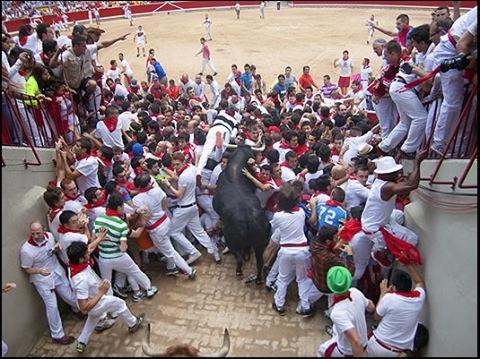 ¡Viva Pamplona! y ¡Viva San Fermín!
¡Viva Pamplona! y ¡Viva San Fermín!
Alexander Fiske-Harrison
P.S. Not to forget the recently turned 50-year-old and friend (in that order) Gary Masi, my co-contributor to Running The Bulls With Hemingway (& Other Pamplona Tales) Matthew Clayfield and his newcomer friend Joseph Woby, Tim Pinks whom I helped a tiny bit with his book Bullseye, Ray Mouton who wrote the book Pamplona, Jesse Graham who wrote the one called San Fermín, Rolf von Essen, Martin Sundberg, Robert Kiely, Warren Parker, Carl Butrum, Victor Lombardi, Reggie Gooden, Carlos Manriquez, the Lombardos, Deidra Carney – daughter of Matt – Catherine Donnell, Maggie Duggan, Pete Sheen, Joan Murray, Deanna, the Pentons, the Prices, Peter C. Remington, the Milligans, the Denaults, Victor, Debbie and Chloe and Gareth and oh God, the list goes on and on, no wonder they edit me… (I even forgot my father Clive!)


